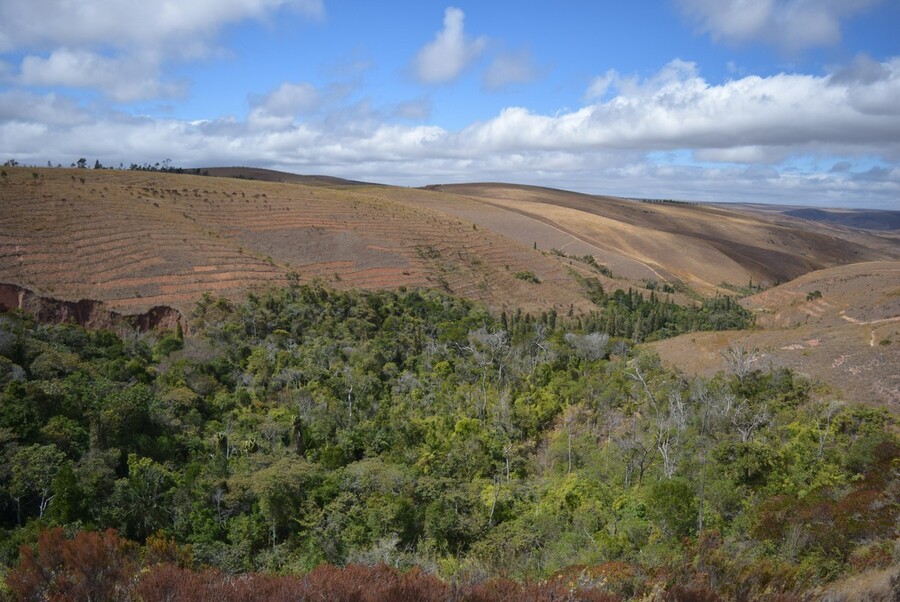12. Day – Ankafobe, a forest at the precipice
Today, on Sunday, Chris and Koto took me to Ankafobe, to the last parts of the highland rainforest of Madagascar. During the first meeting with MBG Christian, the boss of MBG, said that there is no place more worse than this one. I have to agree with him. After leaving the capital, we drove about two hours through a lunar landscape. Just grass and red rocks, some isolated and miserable looking eucalyptus trees and nothing more. The only interruption was some black, carbonated land where it has been burning recently.
Reaching Ankafobe, I could hardly believe how small the last rest of the highland rainforest is and how different it looks like, compared with the barren grassland. I saw a jungle with big trees, palms and excessive green vegetation. I could have been in the tropical primeval forest and would not have noticed the difference, if there has not been the barren, cut down grassland surrounding the jungle. The last rest of the forest nestles against three valleys and takes an area of 33 (!) hectare. What is not very much.
First, we hiked above the forest along the edge of the valley and Chris told me that 80 different trees have been found in this small area. Inwardly I thought that probably just insects, birds and small reptiles could have survived in this forest. But quite the opposite, three species of lemurs are living there, among them the fat-tailed dwarf lemur (16 individuals), the mouse lemur (number unknown) and another lemur (name forgotten, around 30 individuals). The fat-tailed dwarf lemur is on the brink of extinction. The others as well. The next population of fat-tailed dwarf lemurs occurs in another piece of the forest around 130 km away. In spring a researcher from North Carolina passed several nights in the forest to explore the lemurs, for that reason we know the number of the fat-tailed dwarf lemurs. This species has a special characteristic that induced the researcher to came all the way to Madagascar: It hibernates. There are just very few animals doing that.
Highland rainforest in a nursery
Afterwards, Chris showed me the tree nursery, where they are growing seedlings of the different tree species of the highland forest. Around 20.000 seedlings are growing here at the moment. Shortly behind it, there is a research area, where they plant the tree seedlings with or without shadow, either directly at the edge of the woods or with a distance of 20 m on the barren grassland. Suddenly, I heard a shout of surprise, Chris stood in front of the seedlings at the edge of the woods. “That is amazing”, he said. “Look, the tree seedlings at the edge of the woods are growing so much better, does not matter if in shadow or not, than the ones in distance of 20 m at the grassland. That is interesting.”
Indeed, on our way back we discussed what we discovered. In parcels with dynamic agroforestry we also could see that seedlings standing next to big trees, were growing way better than seedlings being farer away. Obviously, the big, old trees take on the job of a wet nurse, we speculate. Or maybe it has something to do with the mushrooms growing at the roots of the old trees that help the younger trees to spread out their own roots?
The idea arose that we reforest a ring of 2 m at the edge of the woods without shadow. As soon as the seedlings have been growing, we reforest the next ring around the forest, another 2 m more. We were happy about this perspective and already saw the forest growing.
Reality catches up very quickly
However, when we were sitting in our car heading back, the reality caught us up. After 5 km we saw fire at the left hand side of the street spreading out very quickly on the grassland. We turned back. Luckily locals have already been there to fight the fire so that it does not jump over street to the other side. There is the edge of the valley where the last highland rainforest is located. Very skilled they set alight a second fire that turned everything flammable along the one side of the street into ash. For that reason they could prevent the fire from spreading on the other side of the street and with it in direction of the forest.
As soon as the second fire turned a stripe of 10 m to charcoal, the original fire came. I was standing on the street with Chris and numerous other people, armed with pulled down branches with many leafs to extinguish possible jumping fires. We already thought ourselves safe, as suddenly an incredibly strong gust of wind rose and knocked us over. Shocked, we looked at the still green side of the street and at the edge of the valley with the 30 hectare highland forest below. No spark has jumped – what luck. 5 minutes earlier and 5 m less burned land and it would have looked a lot different.
A little charred, but relieved I am sending regards from Madagascar.
P.S. What I have forgot, at midday we had a picnic in the forest. Ando and Jose did eat together with us. Jose is the boss of a little, local NGO that are concerned about the forest. We told them about the dynamic agroforestry. Ando has already seen a parcel that looked good, so he thought. If they are interested in a small pilot project with three to five families? Yes, they are. We start in December.
More information about the project

